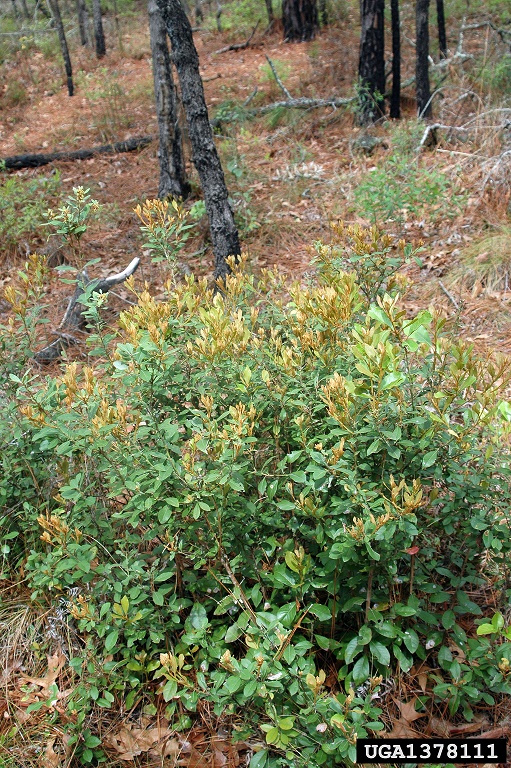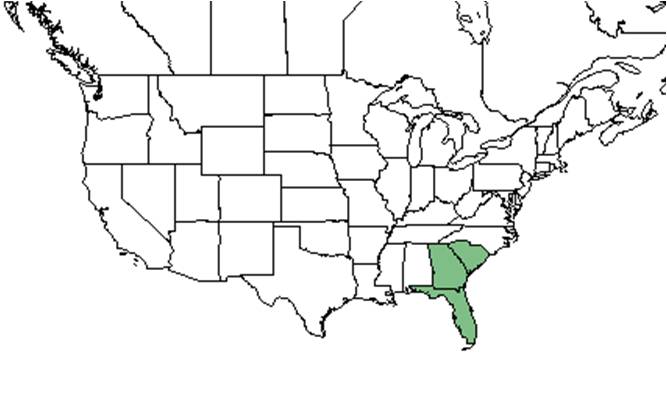Lyonia ferruginea
| Lyonia ferruginea | |
|---|---|

| |
| Photo by Chris Evans, University of Illinois, Bugwood.org | |
| Scientific classification | |
| Kingdom: | Plantae |
| Division: | Magnoliophyta - Flowering plants |
| Class: | Magnoliopsida – Dicotyledons |
| Order: | Ericales |
| Family: | Ericaceae |
| Genus: | Lyonia |
| Species: | L. ferruginea |
| Binomial name | |
| Lyonia ferruginea (Walter) Nutt. | |

| |
| Natural range of Lyonia ferruginea from USDA NRCS Plants Database. | |
Common name: rusty staggerbush
Contents
Taxonomic notes
The species name is Latin for rust-colored, which refers to the rusty appearance on the abaxial side of the leaf [1].
Description
A description of Lyonia ferruginea is provided in The Flora of North America.
Distribution
Populations can be found in south South Carolina, southeast Georgia, and Florida [1].
Ecology
Habitat
Habitats of L. ferruginea in the coastal plain include coastal dunes, titi thickets, longleaf/saw palmetto flatwoods, shrub bogs, live oak scrub sand ridges, and xeric scrubs. It has been found to occur in disturbed areas such as roadsides and powerline corridors. Soil types include sandy loam, loamy sand, peat and white sand. Associated species include Cyrilla, Cliftonia, Rhododendron, Myrica, Lyonia lucida, L. fruticosa, Ilex glabra, Pinus clausa, Quercus chapmanii,, Q. myrtifolia, Ilex ambigua, Serenoa repens, Pinus elliottii, Ilex coriaca, Liquidambar styraciflua, Quercus nigra, Q. incana, Gelsemium sempervirens, Smilax bona-nox, S. pumila, Ptderidium aquilinum, and Aristida stricta (FSU Herbarium).
In a study at the Okefenokee Swamp, Schlesinger and Chabot (1977) found L. ferruginea to be the dominate, evergreen shrub in pine forests surrounding the swamp. It was also observed that the rate of water uptake falls behind the transpiration loss at midday.
Phenology
It has been observed flowering January through April and fruiting January through November (FSU Herbarium).
Seed dispersal
Seed bank and germination
Fire ecology
L. ferruginea occurs in evergreen scrubs that experience a natural fire rotation. Populations occur in the scrubs of Cumberland Island located off the coast of Southern Georgia. These scrubs are pyric disclimaxes and have been found to have a natural fire rotation of 20 to 30 years that are related to coastal drought cycles and the occurrence of dry lightning (Salley and Bratton 1987).
Pollination
The following Hymenoptera families and species were observed visiting flowers of Lyonia ferruginea at Archbold Biological Station (Deyrup 2015):
Apidae: Apis mellifera, Bombus impatiens
Colletidae: Colletes brimleyi, C. productus
Halictidae: Agapostemon splendens, Augochlorella aurata, Augochloropsis sumptuosa
Megachilidae: Megachile xylocopoides
Sphecidae: Oxybelus laetus fulvipes, Stictiella serrata, Tachysphex apicalis
Vespidae: Stenodynerus lineatifrons
Use by animals
Diseases and parasites
Conservation and Management
Cultivation and restoration
Photo Gallery
References and notes
Deyrup, M.A. and N.D. 2015. Database of observations of Hymenoptera visitations to flowers of plants on Archbold Biological Station, Florida, USA.
Florida State University Robert K. Godfrey Herbarium database. URL: http://herbarium.bio.fsu.edu. Last accessed: October 2015. Collectors: Jame Amoroso, Loran C. Anderson, L. Baltzell, Tom Barnes, Linnie E. Beck, James R. Burkhalter, Andre F. Clewell, George R. Cooley, Steven P. Christman, Delzie Demaree, R.J. Eaton, Suellen Folensbee, Mark A. Garland, Angus Gholson, Robert K. Godfrey, D.W. Hall, Walter S. Judd, Robert Kral, H. Kurz, O. Lakela, Robert L. Lazor, Robert J. Lemaire, S.W. Leonard, Fred L. Lewton, Sidney McDaniel, Joseph Monachino, R.A. Norris, Kent D. Perkins, P.L. Redfearn Jr., Ann Redmond, Grady W. Reinert, Cecil R. Slaughter, Bian Tan, L.B. Trott, Kenneth A. Wilson, Carroll E. Wood, Jean Wooten. States and Counties: Florida: Bay, Clay, Columbia, Duval, Flagler, Franklin, Gulf, Hernando, Highlands, Jefferson, Lake, Leon, Levy, Liberty, Marion, Okaloosa, Orange, Osceola, Pinellas, Putnam, St. Johns, Sumter, Suwannee, Taylor, Volusia, Wakulla, Walton. Compiled by Tall Timbers Research Station and Land Conservancy.